There exist:
- Three types of pedals in general
- Two types of ebike overall
- And many types of ebike pedals.
How you decide on which e-bike pedal to use depends on
- the type of ebike you ride
- the type of riding you will do (which depends a lot on the type of ebike…yep, chicken and the egg sort of situation)
Brands generally install good, basic pedals on the ebikes they ship to customers.
However some brands put a LOT of thought into their pedals . . . check out their stories below.
CONTENTS
What is an Ebike Pedal?
Two Types of Ebikes
Ebike Pedal Examples
City, Commuting, General Recreational Ebike pedals
Folding Ebikes
The Colleen: dedicated ebike pedal design
Cargo Ebikes
eMTB Pedals
WHAT IS AN EBIKE PEDAL?
Ebike pedals come from one of three categories of pedal used on modern bicycles:
As a general principle, determining which type of pedal is used on an ebike mainly depends on the rider.
Naturally an ebike brand includes pedals with each new bike; but these can always be replaced or supplemented with another pair depending on the type of riding the user intends.
Flat pedals, also known as platform pedals are the most widely used for ebike pedals.
Their defining characteristic is their broad, level surface which may also incorporate pins or sandpaper to enhance grip.
Clipless pedals are a popular choice for eMTB cyclists and a growing number of road bike cyclists as the uptake in “e” road bikes gathers pace.
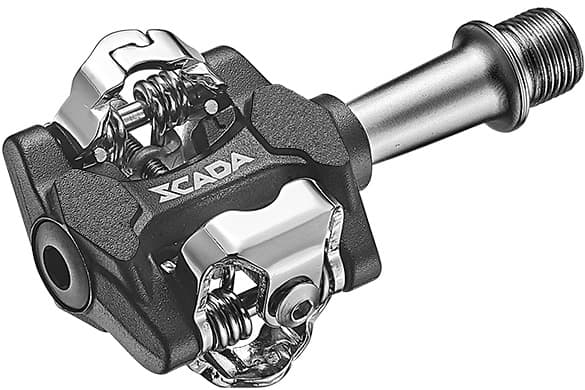
Many eMTB riders have a pair of flats and clipless pedals available depending on the riding circumstances.
Hybrid are a combination of flat and clipless, with a bracket attached to one (and sometimes both)
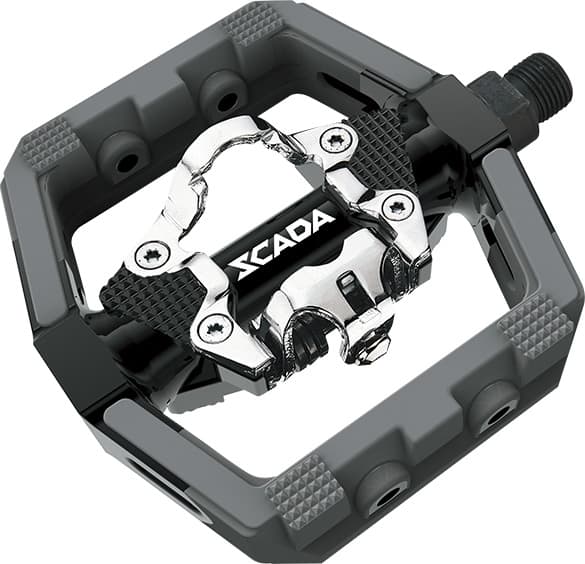
A cyclist has a choice of wearing cleats and clipping in to the bracket depending on the circumstances.
Hardly any ebike pedals are hybrid since clipless pedals are intended for significantly enhancing performance on road bikes or trail MTBs.
Better to go with a dedicated clipless pedal in that case, especially on a road bike. Or opt for a high-performance (grip-enhanced) flat pedal.
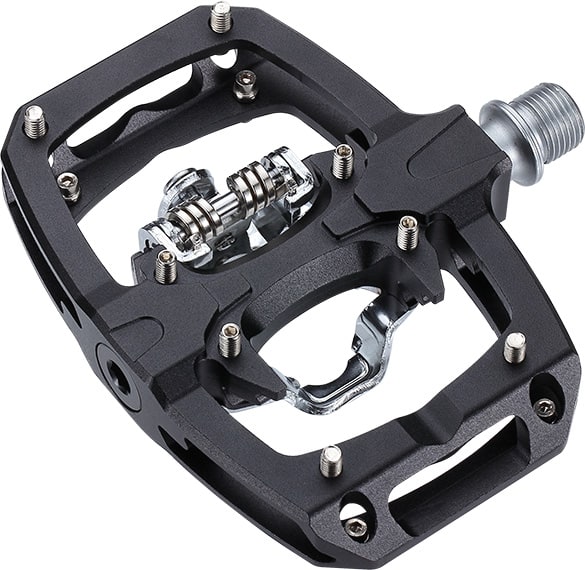
Nevertheless, grip-enhanced hybrid pedals are available for brands to use as is (OE) or craft their own (OD) version; we’ll likely see their increased use in the future as the range of ebikes from existing brands expand product lines, as well as from brands yet to enter the market, particularly in the city and commuting category.
TWO TYPES OF EBIKES
Ebikes are placed in one of two categories:
- pedal assist or pedelec
- hub-drive
The process of selecting a pedal if you are a cyclist or commencing the design process if you are a brand looking to manufacture a set of pedals for an ebike model begins with this difference.
A key area of design is the degree of support and grip incorporated into a prospective ebike pedal
- is the ebike to be mainly used on-road or off-road?
- will the bike be carrying loads (cargo, or trekking?)
Although the drive system is a (little acknowledged) factor in considering pedal type, cyclist preference (or indifference) in the end is the deciding factor.
1. Pedal Assist
Pedelecs are generally powered by a mid-drive motor and lack a throttle.
The motor bolts into a modified bottom bracket shell and begins to channel power expressed as pressure exerted on an ebike’s pedals is detected by the torque sensor.
The degree of power assist to the cranks depends on whether a Low, Medium, or High (or something similar) setting is selected which has potential implications for pedal selection.
A Low setting demands more power input from the rider and less electrical assist; a High setting delivers maximum motor engagement.
2. Hub-drive
The other source of power for an ebike is an electric motor built into the rear or front wheel hub.
Power delivery is controlled by a throttle on some models. Legislation outlaws throttles on hub-drive ebikes in the EU, although it’s permitted in other jurisdictions such as the USA. The EU also legally requires crank sensors.
As these drives become increasingly sophisticated, velocity and cadence sensors as well as torque sensors may be installed on the rear wheel, although torque sensors are much more common on mid-drive models.
Very generally speaking, more support and enhanced grip is often more of an issue for mid-drive ebikes than hub-drives: hub-drive bikes equipped with throttles have much less cause to be concerned with pedal grip.
The devil’s in the details, however, so let’s turn to a consideration of some ebike pedal examples.
EXAMPLES OF EBIKE PEDALS ON A RANGE OF MODELS
If you take a close look at any ebike page online, you’ll note the detailed specifications for almost every component.
The focus of listed specifications is mainly whether the motor is a mid-drive or hub-drive, the battery capacity and expected watt hours, along with the other usual spec.
There is never any mention of an ebike’s pedals let alone the listing of any detailed specifications.
On one level this is understandable since cyclists are free to fit whatever pedal they feel is most suitable or affordable; why worry about a component that a cyclist can easily swap out for a pair that exactly suits their purpose?
Still, many brands clearly give a good deal of thought to the pedals they elect to use on their ebikes.
In the brief selection of ebike pedals considered in this section, city and commuting brands make use of a number of pedal types that loosely reflect the main function of the ebike on which they are fitted.
With eMTBs, however, as you might expect, the range of pedals used are the same as models used in traditional MTBs, due to the performance orientation of mountain bike; clipless and/or flat depending on a cyclist’s preferences (many have a pair of clipless and flat pedals).
City, Commuting, General Recreational Ebike pedals
Ebikes in this category tend to use flat pedals without any grip enhancements.
Only one brand surveyed in this section has created a pedal designed specifically for their bike.
City & Commuting
Gogoro’s Eeyo, unique for the combination of a lightweight carbon frame and ground-breaking hub-drive that also contains the battery, supply a basic platform pedal that belies the Eeyo’s advanced tech.

If not for the outside extension to the cage providing a broader platform able to accommodate a range of footwear, narrow-to-broad, this ebike pedal would qualify as a city bike pedal; city bike pedals have similar simple cages but smaller surface areas.
What’s more, if this one was not anodized black, a silver version would not look out of place on a big-box store bike.
But this is no cheap pedal.
The axle is sure to be chromoly with a quality sealed bearing on the inside and LSL bushing sitting on the outside just inside the hex bolt visible at the end of the axle (the first thing you would see if you removed the bolt).
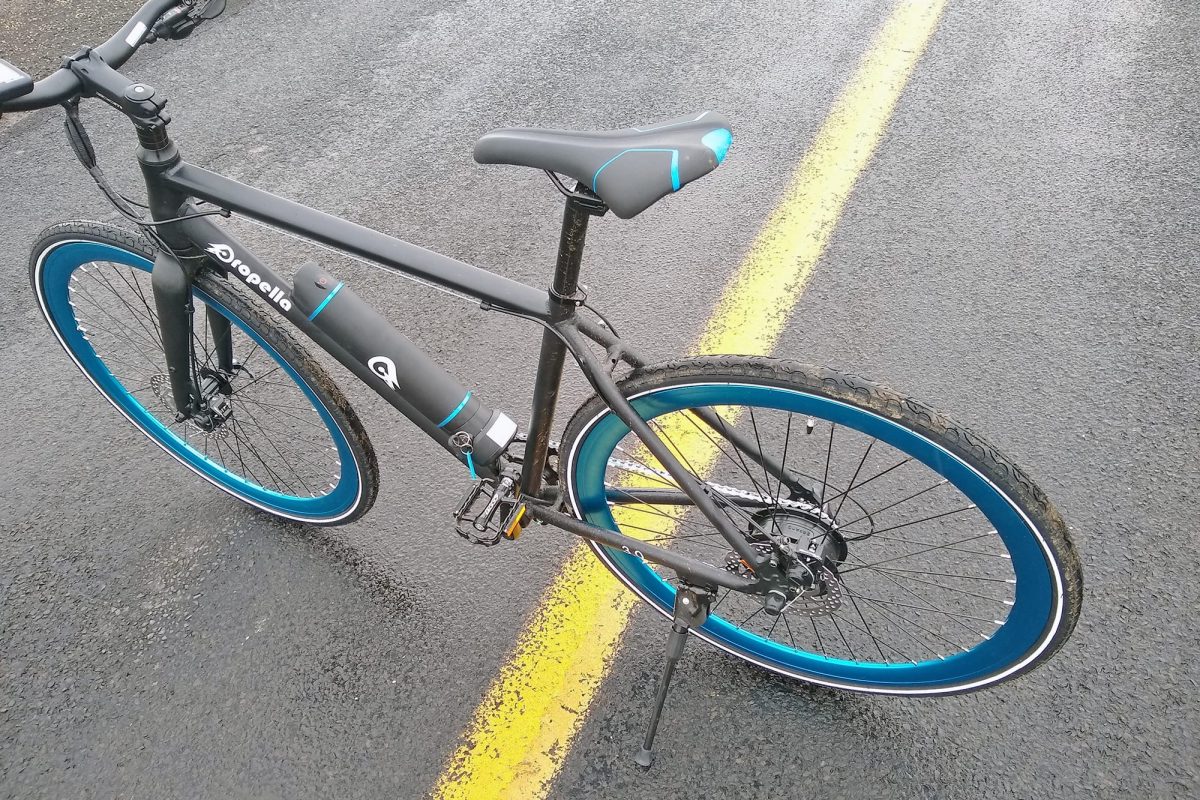
Propella uses a similar pedal to Gogoro, although by the looks of it, the cage is probably broader.

In contrast, Batch Bike uses a broad platform ‘double decked’ ten-pin top and bottom pedal, a type commonly used on mountain bikes.
The gaps in the cage creating the double decker look is a hallmark of sound MTB pedal design; it helps reduce mud build up in pedals on the trail.
The Batch Bike, built around a mid-drive system, is clearly appropriate for touring or trekking where riders are guaranteed to encounter wet and muddy conditions at some time or other.
The broad platform together with the pins provide the grip and stability that help keep shoes on pedals, particularly when starting off under a full load where traction is most required.

The RadRunner Electric Utility hub-drive ebike is built to move cargo around (while stopping short of being a cargo bike), and has a similar set of pedals to the Batch Bike for the same reason.
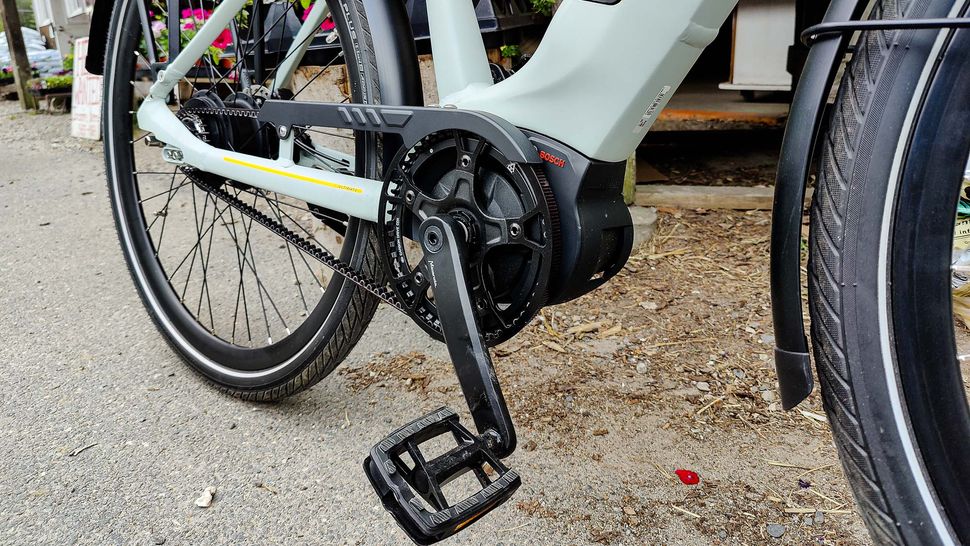
The Gazelle Ultimate C380 HMB mid-drive ebike uses a thick, heavy platform pedal with crenellated grip-enhancing ridges on the front, rear, and outside contact edges.
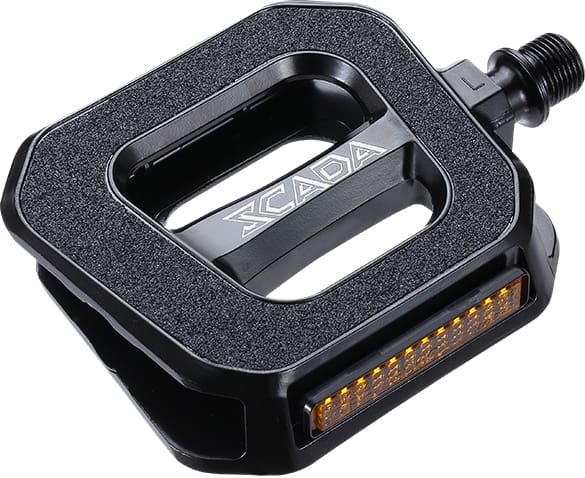
A pedal model such as SCADA’s SC-C832 might be a better choice since the platform is complete — the inside edge connects with the front, rear, and outside edge forming a trapezoid.
Of course, that decision would depend on the particular economy of scale.
The number of pedals in a production affects the cost of each to the brand. This entails a balancing act between the advantages of a higher functioning design versus the margin a brand needs to achieve for a viable production.
Folding Ebikes
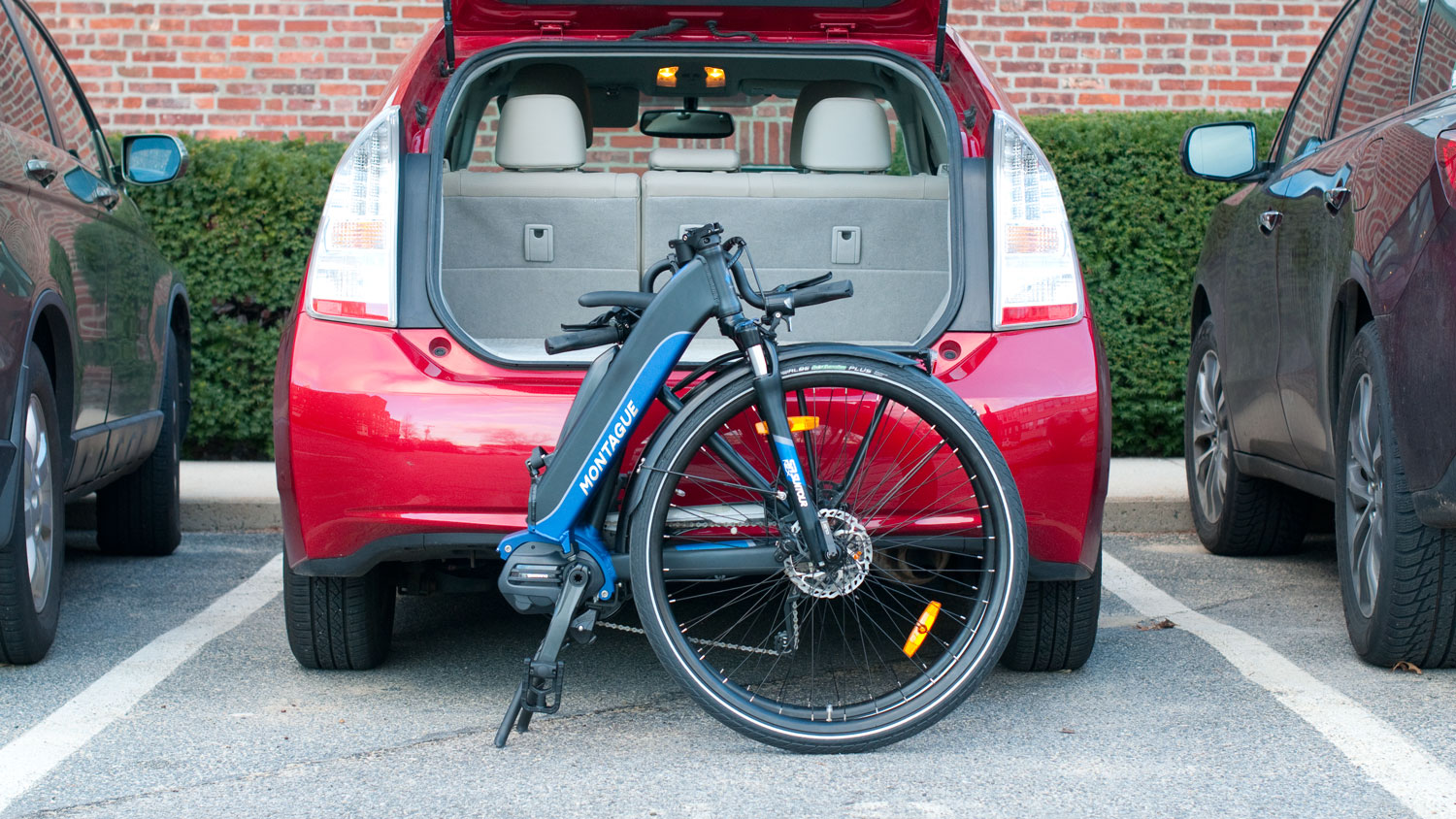
A folding bike logically uses a folding pedal as with this Montague M-E1.

The Swagtron EB5 Pro City uses a robust folding pedal.
The pedals on both have crenellated edges for grip, but since folding ebikes are most likely to be used for urban commuting without much — if any — load.
A cyclist could always replace the brand-supplied folding pedal with a higher end, perhaps even more durable, model of their own.
But that leaves awkward protrusions preventing stowage in tight spaces; when you’ve experienced that often enough, the pure utility of folding ebike pedals is clear.
The Colleen
The creators of The Colleen have designed their pedals to be brand statements over and above their practical utility.
The Colleen’s creators show they know where the bike business is headed, beyond a simple recognition of the centrality of electrified bikes, in their unique pedals, designed in partnership with SCADA.
In the past, a retail brand’s business was aimed at selling bikes to cyclists in which the lifestyle angle, while important, still ranked a (distant?) second to the simple goal of getting a customer on the road or trail.
The lifestyle aspect is now paramount in which bikes are part of various mobility solutionsfor increasingly diverse segments of cyclists.

The buyers The Colleen targets are those recreational and urban users looking for an elegant, fashionable, and sophisticated ebike — not just any old ebike.

Consistent with other brands, the makers of The Colleen do not single out their pedals for any special attention in component spec, even though this pair is not cast from an open mold as with many other brands.
At first glance, The Colleen’s frame appears to be composed of straight lines.

Looking more closely, we see those lines are actually slightly curved — understated curvature is the theme here.
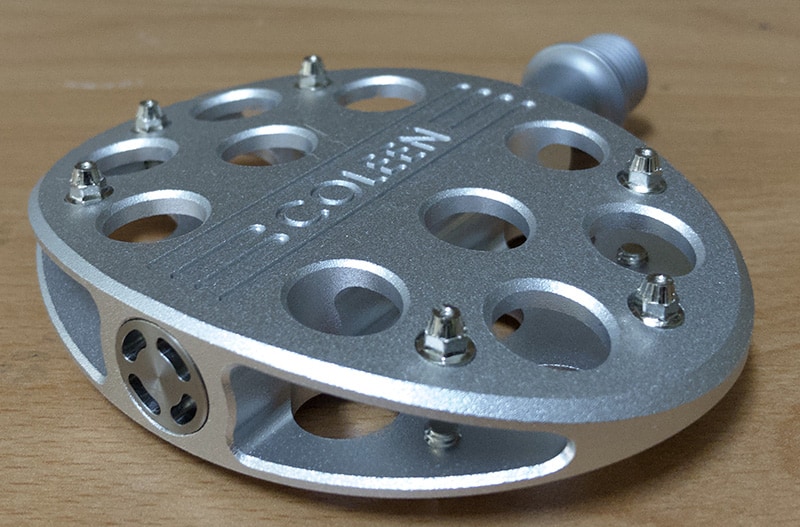
The Colleen pedal’s curved surface is in keeping with that overall design aesthetic, but as a modified ‘flat’ pedal, flat-soled shoes wouldn’t adhere at all well to that curved surface, especially in the wet.
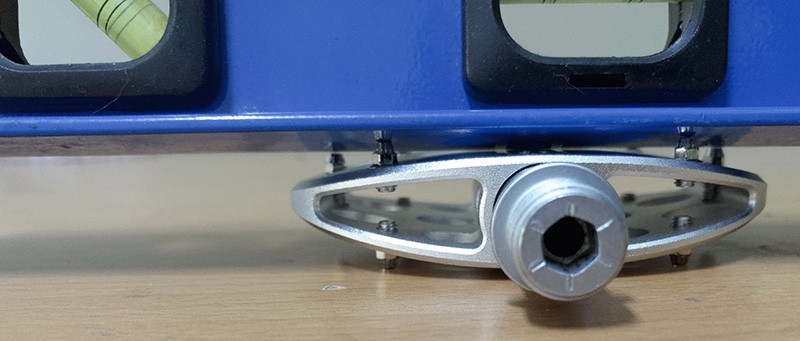
Adding pins returns the pedal to function as a flat pedal, as the pins all live on the same horizontal plane.
The pins ensure non-slip contact for all types of sole which sit neatly on top.
Cargo Ebikes
This is a category of ebike where pedal selection can make a big difference.

Take Tern’s GSD S00 LX Electric Cargo Bike for example, which uses a basic sandpaper cover platform model.
For any ebike, good grip between shoe sole and pedal surface matters; but it’s especially important for e-cargo bikes.
This Tern model has a mid-drive motor; a few initial pedal strokes are required to engage the motor to get the pedal assist working.
A fully-laden cargo bike will take quite a push to overcome stasis inertia and cause the motor to start up — a shoe is more likely to slip on some pedal designs than others.
This trapezoidal pedal’s platform is broader at the crank, tapering slightly to the outside edge, with little excess space, as is common with many flat/platform pedals, which provides maximum foot-pedal contact.
That surface area appears to be covered in sandpaper which is all you need to keep a foot from sliding along or off the pedal, particularly in the wet.
Mountain Ebike (eMTB) Pedals
The mid-drive motors on eMTBs potentially completely eliminate the need for clipless pedals (for riders preferring them over flats).
Surely pedal assist replaces the leverage and torque that clipless pedals afforded (performance-oriented) mountain bike riders?
Well, the significantly greater weight of eMTBs over traditional MTBs and the need to ensure feet remain on pedals in critical situations, or when traversing rough sections of the trail means there’s still advantage to be gained by using clipless pedals.
Anyway, why would riders in competitions refuse the extra torque, in addition to engine torque, that clipless pedals provide?
For everyone else, though, flat pedals with pins will do the job of providing a broad stable surface, grip, and the ability to rapidly and cleanly separate from an out-of-control eMTB during the inevitable crashes.
CONCLUSION
The ebike pedal, as a category, promises to remain well in the background compared with the dominant focus on ebike electronics and other more engaging kit.
However, as the market becomes crowded, and differentiating a brand becomes harder and harder, the clear pathway to success will be to focus on complete mobility solutions.
And a complete mobility solution must, by definition, be attentive down to the last detail, in which how you go is just as important as simple, practical elements of departure and arrival.
eMTB, e-road, and trekking bike pedals will remain practically oriented.
But in the burgeoning categories of city, commuting, and the increasingly fashionable e-cargo bikes, a competitive advantage is likely to be gained by brands paying painstaking attention to detail and deliver big rewards in the years ahead.